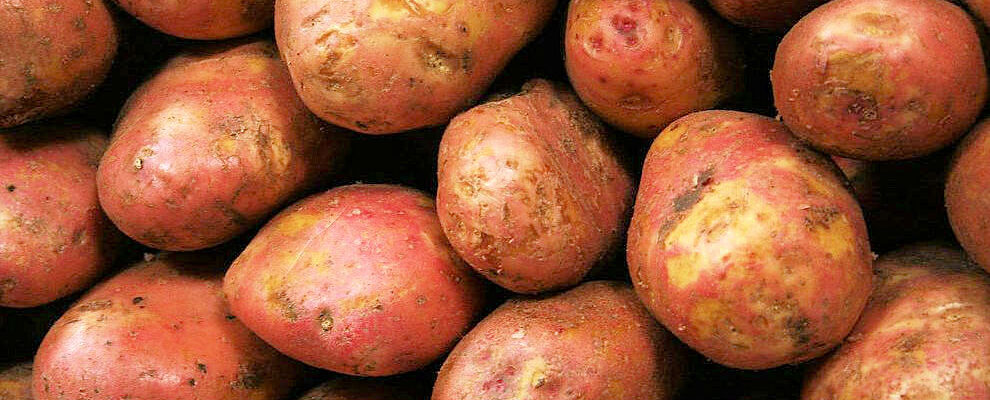Locro is a stew, a classic, staple dish that, while often associated with Argentina, is far more widespread. Versions of locro can be found throughout South America, particularly anywhere that there’s an influence from the cultures that spoke (or speak) the Quechua language. In fact, locro is a name derived from the Quechua “ruqru” or “luqru”, which originally was a traditional stew centered around the papa chola, a particular type of potato with bright yellow flesh and a pinkish skin, but over time has come to refer to a wide variety of stews generally, though not always, based on potato and corn or beans.
There are dozens and dozens of recipes from virtually all of the South American countries for different types of locro. I doubt I’ll ever get to try all of them, nor even make all of them (I have almost three dozen recipes to make at some point or another), but here are my adventures in the kitchen doing the latter. Before anyone writes me to tell me how my recipe doesn’t match your grandmother’s, let me just point out that your grandmother’s recipe doesn’t match your best friend’s grandmother’s recipe either. I’ve spent the time researching, and generally take anywhere from half a dozen to a dozen different versions of the same recipe and try to both distill them down to their essentials, but also use the bits from each that intrigue me.
| Argentina | |
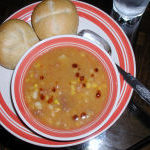 |
Locro criollo – Probably what most folk here in Buenos Aires think of when they think of locro – a stew of dried cracked white corn, squash, a few other vegetables, and a mix of types of sausages and meats, both pork and beef. Generally not spicy, with just a hint of cumin and sweet paprika in it. |
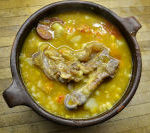 |
Locro de patitas – a variation on the more common locro criollo, and a personal favorite. Unctuous, gelatinous pig’s feet in a stew of dried cracked white corn, sweet corn, potato, sweet potato, squash, tomatoes, onions, garlic, bacon, cured spicy chorizo, cumin, smoked paprika, black pepper, and bay leaf. |
 |
Locro de trigo – instead of the more typical corn or beans, this one is based around whole wheat berries, and includes skirt steak, pork bones, bacon, and fresh chorizos, along with onion, chili, white butter beans, salt, and sweet paprika. I didn’t do a step-by-step writeup, with measurements, but you can get a solid idea of how to do it at the linked post. |
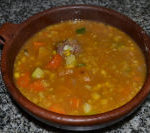 |
Locro de choclo desgranado – here, fresh sweet corn is the star, and even a little non-traditional corncob stock emphasizes the flavor. The whole thing tends a little sweet, with carrots, squash, and sweet potatoes, the fresh corn, grated off the cob, onion, globe zucchini, stewing beef, salt, and hot paprika. |
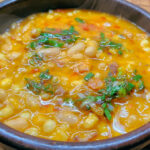 |
Locro catamarqueño – from the northwest mountains of Argentina, this version features pork (and sometimes beef) ribs, cured chorizo, squash, bell peppers, cracked white corn, white beans, and onions, and is garnished with a spicy green onion oil. |
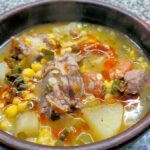 |
Locro de mandioca – from the northeast, the province of Corrientes, this simple recipe features different cuts of beef, cured chorizo, yuca root, globe zucchini, and a whole lot of green onion. We accompany it with a mildly spicy green onion hot sauce. |
| Bolivia | |
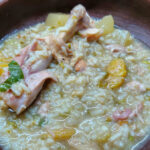 |
Locro Camba – from the area around Santa Cruz, in the northeast of Bolivia, this seemingly distant relation to other locros features a base of rice, yuca, and plantain, with chicken as the protein. Often made more soup-like as well. |
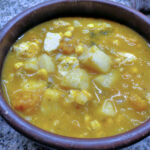 |
Locro Potosino – from southern Bolivia, and the area around Potosí, this is a vegetarian version of the stew featuring squash, potatoes, corn, peas, and cheese. It’s lightly spiced, filling and nutritious, but, kind of uninteresting. |
| Chile | |
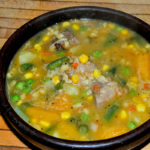 |
Locro mapuche – a relatively easy, more vegetable laden version of the stew. I’m not sure how traditional this version is, there was very little info that I could find online for it, but the base is wheat-berries, along with onions, carrots, celery, squash, potatoes, peas, corn, and green beans. Just one kind of meat in the mix. The spice component is what Chileans call aliño completo, a mix of salt, pepper, cumin, coriander, dry garlic, and oregano. Easy and delicious! |
 |
Locro falso chileno – a vegetarian version of this stew. The base is potato, much more traditional than the version above, along with squash, corn, peas, green beans, carrot, celery, and spiced with a mix of mild chili pepper, oregano, cumin, salt, pepper, and a hint of sugar. The whole thing is topped with a generous amount of grated hard cheese. |
| Colombia | |
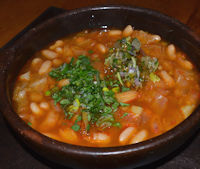 |
Locro de porotos – a very simple bean and cabbage soup flavored and colored with achiote (annatto), and just a touch of cumin and pepper. Typically served garnished with cilantro and green onion and accompanied by either a pineapple or tamarillo salsa. |
| Ecuador | |
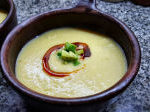 |
Locro de papas – A vegetarian version of locro from the heart of Ecuador. One of the simplest of locros I’ve found so far, with just potatoes, onion, garlic, chili, and vegetable stock in the base, and finished off with some cream (or milk), egg, and cheese. Avocado is a traditional garnish, or mix-in, at the last moment. |
 |
Locro de camarón y choclo – similar to the above, but has its differences in spicing in particular. Potatoes, corn, celery, cream, milk, achiote paste, and either shrimp or fish stock. Traditionally garnished with a mix of avocado, green onion, red chilies, and lime wedges. |
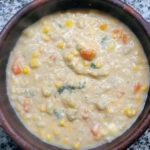 |
Locro de choclo – another similar one, though a different approach to making it, and focused on the potatoes and corn. Vegetarian, though not vegan, as it’s heavy on the dairy. |
| Peru | |
 |
Locro de zapallo (con cordero) – A squash based locro that’s traditional from the Amazon basin mountain regions of Peru, usually containing more than one kind of squash, plus corn, onions, garlic, and broad beans. Generally it’s mildly spicy with a puree of ají mirasol or ají amarillo, and uses a mix of herbs, the most prominent being huacatay, or Amazon black mint. |
| Uruguay | |
 |
Locro uruguayo – Mixed beef, pork, and tripe locro with corn, chickpeas, and beans, plus the common squash, potatoes, and sweet potatoes. A bit more tomato-ey than most of the others we’ve tried. Not hugely different from many Argentine versions, but then, we are neighbors. |
